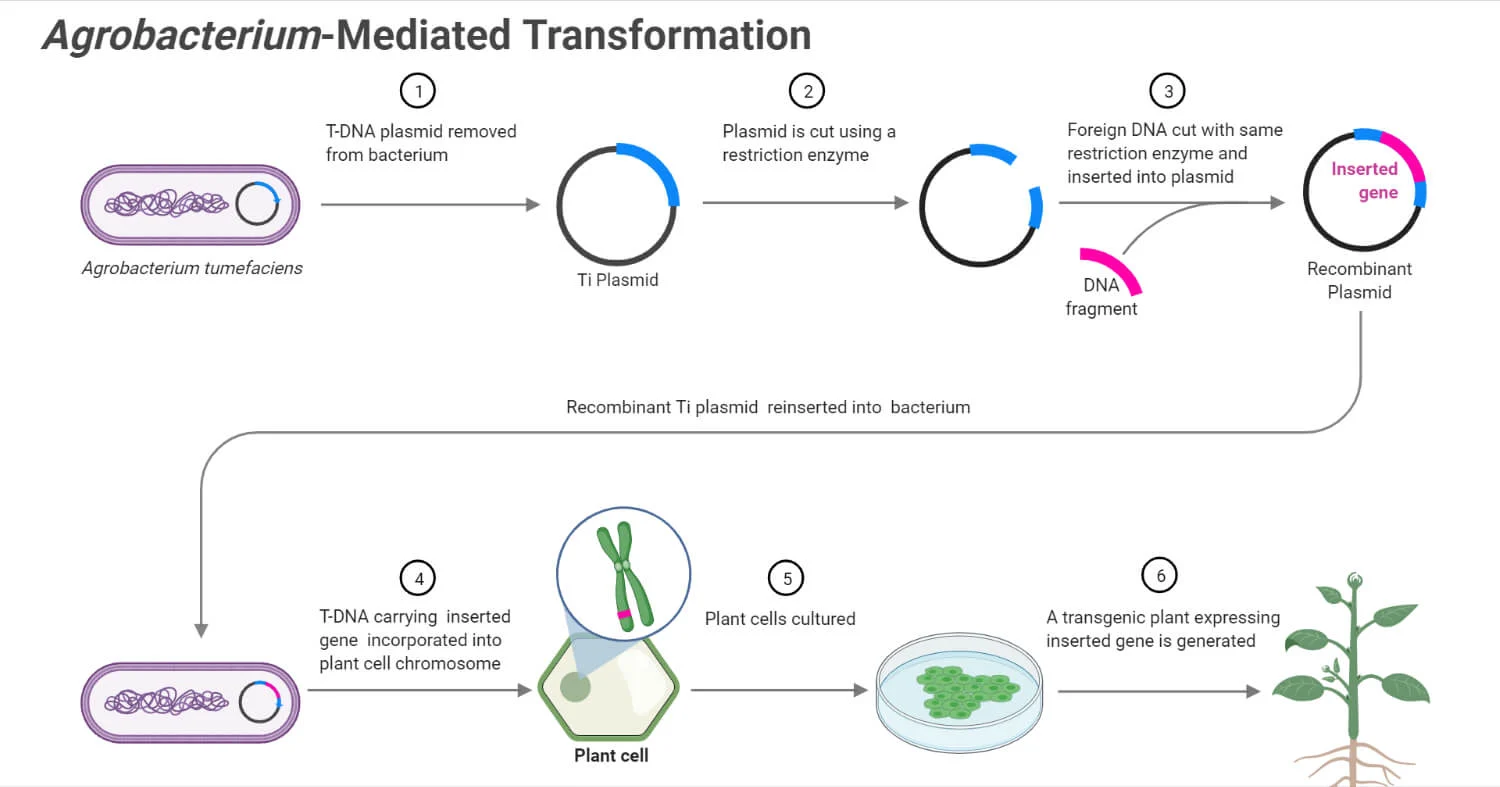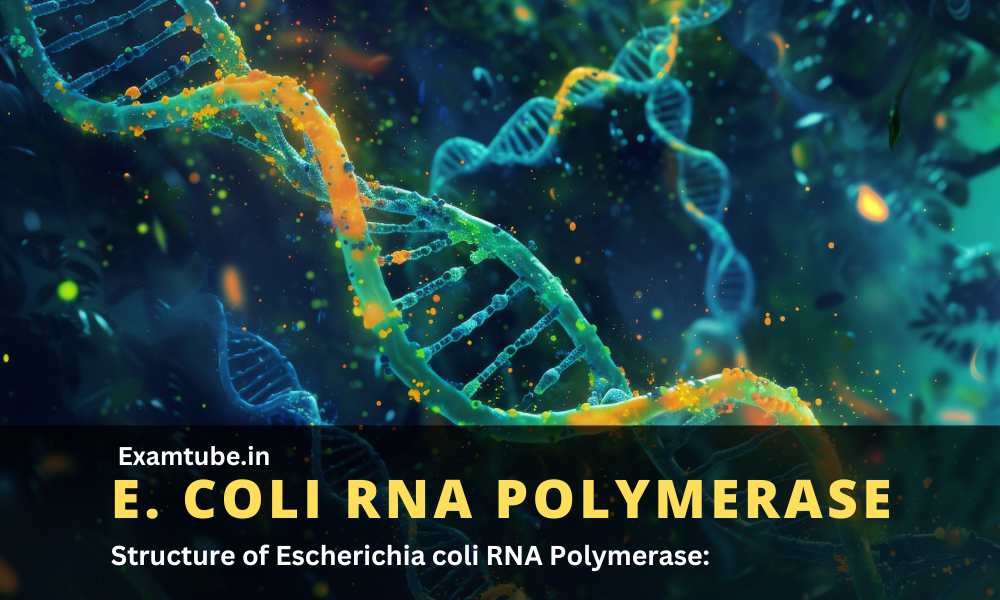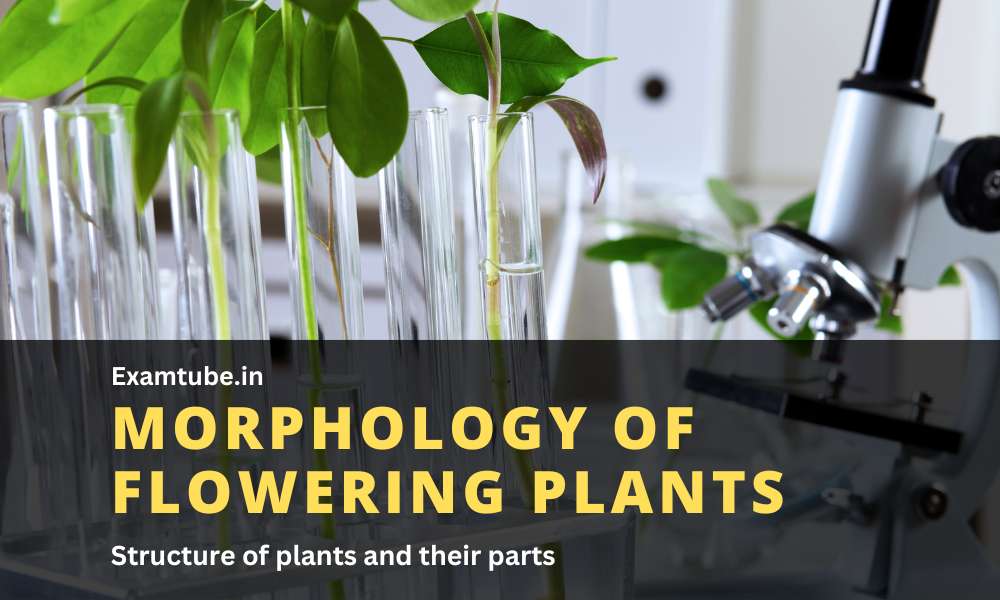Agrobacterium is a phytopathogen that infects plants through wound sites, causing crown gall disease, and is one of the most popular plant transformation tools used in agriculture to date.
- Agrobacterium tumefaciens is
the soil pathogen that utilizes its bacterial type IV secretion system for
the transfer of its transferred (T)-DNA into the host cells.
- The
genus Agrobacterium consists of different species
depending on their disease symptomology and host range. Some of the
species of Agrobacterium include A. radiobacter,
A. vitis, A. rhizogenes, A. rubi and A. tumefaciens.
- The
organisms of this genus are most notably known as plant transformation
tools used in a wide range of host cells.
- The
host range of the bacteria is determined by different bacterial as well as
plant factors. Bacterial factors include virulence genes and T-DNA
oncogenes, whereas the plant factors include genes required for
transformation and tumor formation.
- The
natural diversity of the bacteria is determined based on the presence of
the primary pathogenic determinant, the Ti/Ri plasmid.
- Different
strains of Agrobacterium can be isolated from all around
the world in a wide range of host plants. Some of the common host plants
include roses, poplar, weeping fig, chrysanthemum, and other fruit trees.
- The
presence of different plasmids and the ability of the organism to transfer
a DNA segment with the tumor-inducing plasmid into the genome of the host
cell is the primary factor behind the use of Agrobacterium in
plant transformation.
- Agrobacterium is
a Gram-negative rod-shaped bacterium ranging in size from 1.5 to 3 µm in
length and 0.6 to 1.0 µm in width. The bacterium is motile with one or as
many as six flagella.
- These
do not form spores and are strictly aerobic organisms residing in soil
with clinical as well as biotechnological applications.
Factors affecting Agrobacterium-mediated Gene Transfer
- There
are a number of methods that are employed to obtain transgenic plants,
some of which include Agrobacterium-mediated transformation,
particle bombardment, protoplasts mediated by polyethene glycol, and
liposome-mediated transformation.
- Among
all these methods, Agrobacterium-mediated transformation
results in single-copy transgenes, which are comparatively more stably
expressed than multiple gene copies.
- The
process is, however, influenced by different factors like bacterial
strains and cell density, plant species, plant growth regulators, and
environmental factors.
- In
order to develop an efficient transformation protocol, it is necessary to
find the right combination of these factors.
The following are some of the factors that influence Agrobacterium-mediated
transformation;
Explants
- Explants
are target material for Agrobacterium-mediated transformation,
which can be embryonic cultures, immature embryos, mature
seed-derivatives, leaf blades, and even stem segments.
- The
selection of explants should be made so as to ensure the recovery of the
whole transgenic plant.
- Different
studies have taken place to determine the best explants for an efficient
transformation process.
- Embryonic
callus derived from mature seeds is considered one of the best explants
for Agrobacterium-mediated transformation in certain plant
species.
- It
has been discovered that one of the essential factors that enhance
transformation is the desiccation of explants prior to or after Agrobacterium infection.
- The
differences in the efficiency of the transformation on different plant
tissues have been attributed to the differences in the ability of the
bacteria to attach to the plant cells and the differences in the T-DNA
transfer mechanism.
Explants Wounding
- Wounding
of explants is required for the efficient Agrobacterium-mediated
transformation.
- The
type and method of wounding can range from simple wounds during explants
preparation to particle gun-mediated micro-wounding.
- There
are other forms of wounding that include Agrobacterium-filled
syringes and sonication.
- Transformation
is also enhanced by the formation of micro wounding on the surface and
sub-surface layers of targeted tissues, resulting in the release of
phenolic compounds.
- The
efficiency of transformation also depends on the application of additional
phenolic substances.
Plant species and Genotype
- The
differences in the efficiency of Agrobacterium-mediated
transformation in different plant species are due to the differences in
inducer molecules.
- The
success of transformation depends on the chromosomal and plasmid genomes
that encode all materials required for attachment and DNA transfer.
- Different
plants have different levels of vir gene expression in different hosts,
which affects the sensitivity to infection by Agrobacterium.
- Even
within the same species, several cultivars or ecotypes exhibit varying
degrees of susceptibility to tumorigenesis by Agrobacterium species.
- Most
of the Agrobacterium-mediated transformations are performed on
dicotyledonous species, but more recently, the frequency of gene transfer
in monocotyledonous species has increased.
Antibiotics
- During
transformation, the cocultivation is followed by the suppression of bacteria
so as to not interfere with the growth and development of the host plant.
- The
elimination of the bacteria is achieved by the use of one or more
antibiotics in the culture medium.
- Some
of the commonly used antibiotics are carbenicillin and cefotaxime. The
type of antibiotics used also depends on the plant species and the Agrobacterium strains.
- It
is essential to determine the correct ratio of antibiotics to achieve
antibiotic selection and an adequate rate of tumorigenesis.
Plant Growth Regulators (PGR)
- Plant
transformation also requires the addition of plant growth regulators, and
the correct choice of regulators is one of the most important factors
affecting the process.
- The
competence and susceptibility to Agrobacterium infection
in recalcitrant explants is either low or absent in the absence of PGR
treatments.
- The
presence of 2,4-D in the growth medium during the cocultivation process is
known to enhance transformation efficiency.
- The
use of growth regulators facilitates cell division and differentiation in
many tissues; however, the use of regulators should be done at a
particular stage of the plant cell cycle.
Light
- Light
is an important factor that affects the efficiency of Agrobacterium-mediated
transformation as light affects different physiological factors in the
plant like the plant hormone levels, cell proliferation, and cell cycle
stage.
- Light
has also been known to increase the amount of the phenolic vir gene
inducer, which affects the transformation process as it regulates the
T-DNA transfer.
- Various Agrobacterium-mediated
transformation processes utilize dark co-culture conditions to improve the
morphology of the explants.
- Some
studies have also indicated that the effect of light on the process is
primarily based on the photoperiod.
Temperature
- Early
studies related to the efficiency of Agrobacterium-mediated
transformation indicate that high temperature was detrimental to tumor
development.
- A
temperature of about 32°C is known to suppress tumor development due to
conformational changes in the virA genes. The optimal temperature for the
transfer of T-DNA was found to be 19°C.
- The
optimal temperature for the transfer might differ in different species,
but the temperature range of 19°C to 22°C was considered ideal for many
plant species.
Agrobacterium Strains
- The
infecting ability of different Agrobacterium strains is
different depending on the presence of different plasmids.
- The
most efficient group of bacteria used for transformation is the
combination of a standard binary vector in a super-virulent strain and a
super binary vector in a regular strain.
- Different
combinations of Agrobacterium strains might be used for
different species of plant cells.
Principle of Agrobacterium-mediated Gene Transfer
- The
basis of Agrobacterium-mediated transformation is the ability
of the organism to transfer its T-DNA into the host cells efficiently.
- The
biology of the process consists of two components; the T-DNA consists of
25 bp repeats that end at the T-region and the virulence (vir) region
composed of seven major loci.
- The
mechanism of Agrobacterium-mediated transformation is based on
the transfer of a piece of plasmid by the bacteria into the plant cells
during infection.
- The
plasmid then integrates into the nuclear genome in order to express its
own genes and affect the hormonal balance in the host cell.
- Besides,
the bacteria also produce a number of enzymes that are involved in the
synthesis of opines that is then used by the bacteria as nutrients.
- Some
of the essential components of the bacteria involved in infection are
T-DNA present on the plasmid called Ti (tumor-inducing) plasmid along with
other functional components like virulence (vir), conjugation (con), and
origin of replication (ori).
- The
infection begins with the entry of the bacteria through wounded sites. The
binding of bacteria to the plant cells is enhanced by the release of
phenolic acetosyringone (AS) by the injured plant cells.
- The
AS activates the VirA proteins on the bacteria, which activates VirG via
phosphorylation of its aspartate residue.
- The
activated form of VirG then binds to other vir genes, inducing their
expression. VirD activated by this process stimulates the T-strand
generation (a single-stranded copy of the T-DNA).
- The
VirD2 covalently binds to the 5’ end of the T-strand as the 5’ end is the
leading end during the transfer. Other factors like VirE2 and VirB
proteins also bind to the T-strand, forming a T-complex.
- The
complex is then passed into the nucleus by the nuclear target signals
released by the Vir proteins. The T-DNA strand is integrated into the
plant genome randomly as either a single copy or multiple copies.
- The
integration usually occurs in the transcription active or repetitive
regions of the genome by the process of recombination.
- Even
though much is known about the molecular biology of T-DNA transfer
in Agrobacterium cells, not much is known about the
plant-encoded factors involved in the process.
Requirements (Materials and Reagents)
Materials/ Equipment
- Sterile
50 ml plastic tubes
- Autoclave
- Controlled
Tissue Culture Rooms at 25°C with 16/8 hr light/dark period
- Shaker
Incubator
- Vacuum
pump
- Laminar
hood for tissue culture
- Glassware
(Beakers, cylinders, Petri dishes, Duran bottles, and Flasks)
- Filter
paper
- Parafilm
- Forceps
and Scalpel
- Pipettes
- Centrifuge
- Spectrophotometer
- Tissue
culture vessels
- Surgical
blades
Reagents
- Explant
(Stems, embryo, cotyledons, or other tissues)
- Agrobacterium strain
- 13%
Sodium hypochlorite
- B5
Medium
- Agar
- Tryptone
- Yeast
Extract
- Sodium
Chloride
- 35%
Hydrochloric acid
- Sterile
distilled water
- 75%
Ethanol
- Sucrose
- Abscisic
Acid
- Rifampicin
- Kanamycin
monosulfate
- Gellan
gun powder
- PCR
primer star Mix
- Carbenicillin
disodium salt
Media Preparation for Agrobacterium-mediated Gene Transfer
LB medium for Agrobacterium culture
- 5
grams of yeast extract, 10 grams of tryptone, and 5 grams of sodium
chloride are dissolved in 1 liter of distilled water.
- To
50 ml of the LB medium, 50 µl of 100 mg/ml rifampicin stock and 50 µl of
50 mg/ml kanamycin stock are added.
Murashige and Skoog medium for seed germination
- 4.43
gram of Murashige and Skoog basal medium power and 3 gm of sucrose are
added to 1 liter distilled water.
- To
this, 2.5 gm gellan gun powder is added and autoclaved. 25 ml of this
medium is poured on Petri plates under laminar flow.
Cocultivation medium
- To
the Murashige and Skoog basal medium, 750 µl of 2 mg/ml BAP is added.
Again, 500 µl of 2mg/ml ABA is added to the medium.
- 25
ml of the medium is poured onto sterile Petri plates in the laminar flow.
Shooting Medium
- Shooting
medium is prepared by adding 50 µl of 50 mg/ml kanamycin and 2.5 ml of 200
mg/ml carbenicillin to the cocultivation medium.
Rooting Medium
- Rooting
medium is prepared by adding 50 µl of 50 mg/ml kanamycin and 1 ml of 200
mg/ml carbenicillin.
Procedure or Protocol of Agrobacterium-mediated Gene Transfer
The protocol or procedure for the Agrobacterium-mediated
transformation might differ depending on the type of explants selected for the
process. The following is the protocol for Agrobacterium-mediated
transformation in the case of an embryo;
Sterilization and Germination of seeds
- The
seeds are sterilized with Cl2 for 1-2 hours, and the seeds are then
soaked in water for 2 hours at room temperature in a Petri dish.
- The
seed coats are removed with forceps from the seed and are further
sterilized with 75% ethanol for 30 seconds. These are then rinsed with 20
ml of the 3% sodium hypochlorite.
- The
sterilized seeds are placed on Petri plates containing seed germination
medium and are incubated at 28°C for 2 days in the dark. Each plate can
contain about 15-25 seeds.

Inoculum Preparation
- 2
ml of the LB medium containing rifampicin and kanamycin is inoculated with
a single Agrobacterium colony. The culture is then
incubated in the shaker incubator at 28°C.
- The Agrobacterium culture
prepared is centrifuged at 4000g for 10 minutes. The supernatant is
removed, and the pellets are cleaned with a 1 ml MS liquid medium.
Preparation of the explants
- The
seeds are pulled out of the germination medium and are placed on empty
sterile Petri plates with a stack of filter papers.
- The
radicle is removed, and the seed is cut to remove ½ of the cotyledons and
endopleura.
- The
cotyledons are separated with a sterile scalpel and are wiped off. The
detached cotyledons are collected into the MS liquid medium in a sterile
glass beaker.
- The
MS liquid medium containing the cotyledons are poured into MS liquid
medium containing Agrobacterium and shaken gently.
- The
glass beaker is covered with a container and sealed with film, and ut into
the desiccators attached to the vacuum pump.
- The
explants are left on the medium for 5 minutes after two sessions of vacuum
infiltration.
- A
sterile filter paper is packed on the cocultivation medium, and the
infected explants are placed on the filter paper with forceps. The adaxial
surface of the cotyledon is to be kept upwards.
- The
Petri plates are then sealed and incubated in the dark for 2 days at 28°C.
Shoot Initiation
- The
explants are then transferred to the shooting medium containing kanamycin
and carbenicillin in order to inhibit the growth of Agrobacterium.
- Every
plate can contain 5-6 explants that are then incubated under light for 2-3
weeks at 25°C.
Regeneration
- Once
the shoots begin to appear on the explants, these are pulled out and
placed on sterile Petri plates with a stack of filter paper.
- The
shoots are cut off with a sterile scalpel, and the embryoid part of the
shoots are removed.
- The
shoots are then transferred to a 100 ml glass flask or tissue culture
vessels with a rooting medium.
- About
3-4 shoots can be added per vessel. The vessels are incubated under light
for 1-2 weeks at 25°C.
- After
2 weeks, if no roots are observed, the unfolded leaves and end parts of
the shoots are cut off, and the shoots are transferred to a new rooting
medium.
Plant acclimation
- After
the roots begin to appear, the over on the flasks are loosened and further
incubated at 25°C for 3 days.
- The
plants are then pulled out from the medium and washed off with running
water.
- These
are then transferred to pots filled with wet compost and watered.
- The
pots are covered with zip bags to keep the moisture. These are incubated
in a good condition chamber under light at 25°C for 1-2 weeks.
- Once
the plants grow in good condition, the zip bags are removed, and the
plants are watered.
Applications of Agrobacterium-mediated Gene Transfer
The following are some of the important applications
of Agrobacterium-mediated transformation;
- The Agrobacterium-mediated transformation
has been used as a method of genetic modification of plants for the
production of various substances like proteins, antibodies, and even
vaccines.
- Different
plants have also been modified to produce life-saving pharmaceutical
products like anticoagulants, human epidermal growth factors, and
interferons.
- Transgenic
plants prepared with Agrobacterium serve as biomonitors
to detect the presence of toxic compounds in the environment as well as to
detoxify the contaminated soil and water.
- Agrobacterium-mediated
transformation has also remarkably increased crop yields by modifying the
shelf-life and biosynthesis of the plants.
- Plants
can be modified to enhance tolerance against biotic and abiotic factors,
nutrient capture with increased pest resistance.
- Agrobacterium-mediated
transformation has been used to produce insect resistance crops by the
incorporation of various toxic genes like the Bt toxin genes.
- The
increase in pest resistance results in a reduction in the use of harmful
agrochemicals and herbicides.
- Agrobacterium-mediated
transformation is one of the less complicated genetic engineering
techniques which has the possibility of being upgraded to use with other
organisms as well.
Limitations of Agrobacterium-mediated Gene Transfer
Even though Agrobacterium-mediated
transformation has been advancing over the years with much success, there are
some problems and limitations associated with this technique. Some of the
commonly encountered limitations and problems with the technique are;
- The
most important limitation associated with this technique is the narrow
host range, as it is still limited to particular plant species.
- Even
though a lot is known about the mechanism of T-DNA transfer in the
bacteria, not much is known about the plant-encoded factors that affect
the efficiency of this process.
- The
technique is labor-intensive as it requires the development of plant
regeneration protocols and detailed time-consuming processes. Many of
these processes are prone to in vitro variations, resulting in unfavorable
results.
- The
success of transformation in the case of monocots depends on the use of
embryos as the explants; however, these are only available for a short
period of time during the year.
- Agrobacterium-mediated
transformation cannot transfer large DNA molecules into more economically
important plants, which indicates a possible introduction of a powerful
vector system.









Comments